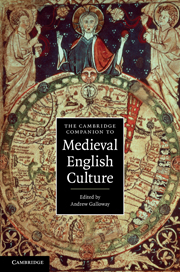Book contents
- Frontmatter
- Introduction
- Part one Theaters of culture: political, legal, material
- Part two Cultural ideals and cultural conflicts
- 4 Social ideals and social disruption
- 5 “Celtic” Visions Of England
- 6 The idea of sanctity and the uncanonized life of Margery Kempe
- Part Three Literacies, languages, and literatures
- Part four Legacies and re-creations
- Guides to further reading
- Index
6 - The idea of sanctity and the uncanonized life of Margery Kempe
from Part two - Cultural ideals and cultural conflicts
Published online by Cambridge University Press: 28 July 2011
- Frontmatter
- Introduction
- Part one Theaters of culture: political, legal, material
- Part two Cultural ideals and cultural conflicts
- 4 Social ideals and social disruption
- 5 “Celtic” Visions Of England
- 6 The idea of sanctity and the uncanonized life of Margery Kempe
- Part Three Literacies, languages, and literatures
- Part four Legacies and re-creations
- Guides to further reading
- Index
Summary
Although medievalists sometimes use the word “sanctity” as a synonym for “sainthood,” people in the later Middle Ages rarely did. Rather, Middle English saunctite, like the Old French saintete and the still earlier Christian Latin sanctitas, tends to have amore general meaning, suggesting a state of blessedness or a righteous manner of living rather than canonized sainthood in a strict sense. In a story from the Middle English translation of the Gesta Romanorum, for instance, in which a young woman's supernatural ability to create a shirt from a tiny piece of cloth is moralized as the Incarnation, Mary's womb is described as having undergone “sanctificacion” (sanctificatio). In this instance, the use of the word “sanctity” highlights Mary's body itself, as the vessel of creation and a site of blessedness, rather than drawing attention to her place in the roster of saints.
More common still was the sense of “sanctity” as lived righteousness. In Piers the Ploghman's Crede (c. 1390), one of the friars interviewed by the naive narrator describes “the pure Apostells life” that he and his brothers claim to imitate: they “suen hem in saunctite, and suffren well harde/ . . . and in wo lybbeth/In penaunce and poverte, and precheth the puple,/By ensample of oure life.” Despite the poem's satirical nature, saunctite's meaning here connotes a way of life in which actions accord with spiritual ideals. In these medieval works, sanctity is a lifestyle and not, in a narrow sense, sainthood.
- Type
- Chapter
- Information
- The Cambridge Companion to Medieval English Culture , pp. 129 - 146Publisher: Cambridge University PressPrint publication year: 2011
- 3
- Cited by



